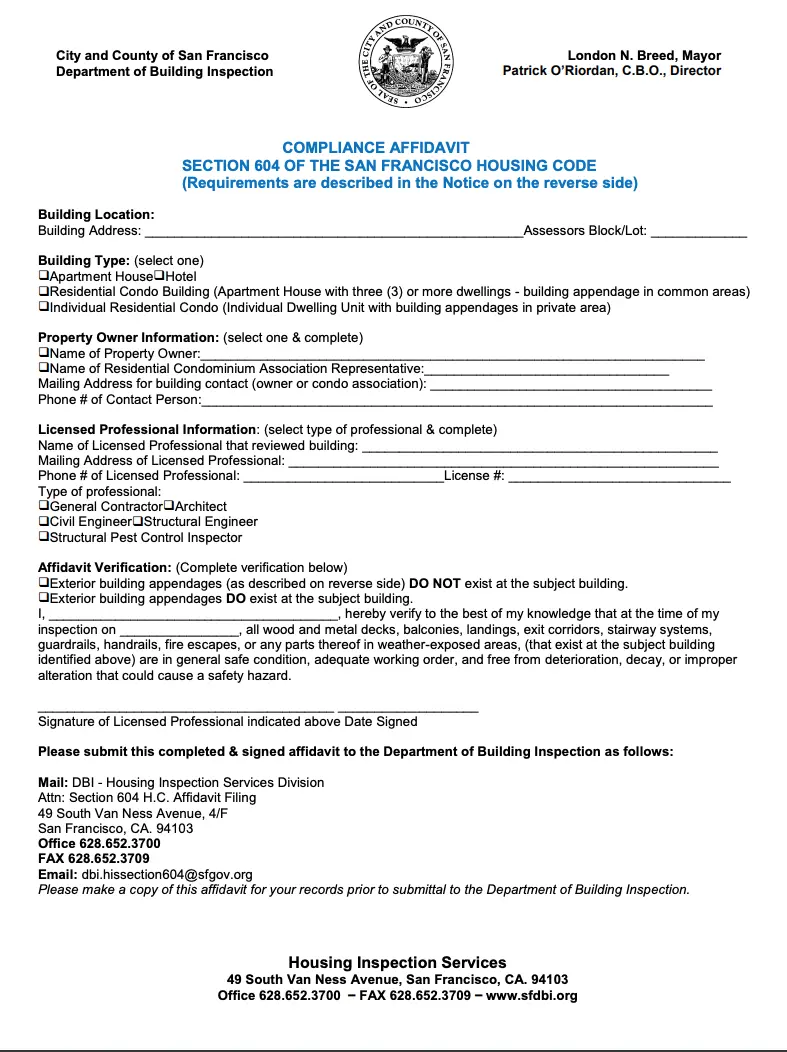Navigating the world of safety and compliance can often feel overwhelming. However, for San Francisco residents and businesses, understanding the significance of regular 604 certifications is crucial. These certifications ensure the safety and integrity of properties and infrastructure, providing peace of mind to all stakeholders involved. In this blog, we will delve into what the San Francisco 604 certifications entail, why they are important, and how to stay compliant.
Understanding San Francisco 604 Certifications
San Francisco 604 certifications primarily focus on the safety and structural integrity of buildings. This mandatory certification plays a crucial role in maintaining public safety by ensuring that properties meet all necessary safety requirements and standards. These certifications require a thorough examination of various components within a building, particularly focusing on parts like fire escapes and structural integrity, which are crucial for emergency situations. Given San Francisco’s unique landscape and dense urban environment, maintaining these safety standards is essential to protect lives and properties alike.
The necessity of these certifications cannot be understated, as they provide a framework within which property owners must operate to ensure their buildings are up to code. In cities like San Francisco, where aging infrastructure can be a frequent challenge, these assessments help to identify vulnerabilities before they escalate into tragedies. Therefore, the San Francisco 604 certification is not just a legal requirement but a proactive step towards ensuring the integrity and reliability of urban safety measures.
The Significance of Regular Inspections
Regular inspections are vital as they help identify potential issues before they become significant problems. These inspections are not only about compliance but also about protecting property investments and ensuring tenant safety. Specifically, inspections often reveal wear and tear on fire escapes and other safety features that might otherwise go unnoticed, offering an opportunity to address these problems early. Ensuring your property is compliant with the San Francisco 604 code means you are not only protecting its value but also building trust with tenants and the community. The last thing anyone wants is an emergency where safety measures fail to work. Therefore, keeping up with inspections could truly mean the difference between minor repairs and major catastrophes and fire escape readiness.
Furthermore, these routine checks are instrumental in preparing for unexpected situations, such as natural disasters or fires, that necessitate immediate evacuation. Regular inspections greatly enhance response efficiency, ensuring that systems like fire alarms and emergency exits function correctly. When inspections are skipped or delayed, it drastically increases the risk of malfunction during critical moments, which can result in catastrophic outcomes. By engaging in proactive inspections, you’re taking decisive, actionable steps towards creating a safer living and working environment for everyone involved.
How to Obtain a 604 Certification
To acquire a 604 certification, property owners must engage certified professionals to inspect their buildings. This process typically involves an in-depth evaluation of the building’s structure, ensuring adherence to safety standards. For property owners, this means enlisting the help of recognized agencies that specialize in thorough safety evaluations and creating an environment of ongoing dialogue about maintenance needs. Once an assessment is completed by a qualified inspector, recommendations might include repairs or upgrades to bring the building up to the code required under the San Francisco 604 regulations.
Owners should familiarize themselves with the standard procedures involved in obtaining the certification, which includes contacting local authorities or certified entities that conduct these kinds of inspections. By planning ahead and understanding what needs to be done, property owners can streamline the process and avoid any unnecessary complications. Consistent communication with inspectors and repair professionals can prevent delays and ensure the job is done right the first time, which saves time, money, and most importantly, enhances safety.
Consequences of Non-Compliance
Failing to maintain an up-to-date 604 certification can lead to severe consequences, including fines and legal action. Additionally, non-compliance increases the risk of accidents, which can result in liability issues and damage to property reputation. The economic impact of not following the certification process can be significant, with potential lawsuits, insurance complications, and the cost of emergency repairs quickly adding up. In an extreme scenario, tenants or employees might refuse to occupy a non-compliant property, leading to loss of business and rental income. Moreover, neglecting compliance with the San Francisco 604 standards could put lives at risk, undermining public trust and potentially resulting in tragic outcomes. Therefore, obtaining and maintaining certification is fundamental to both property owners and the community at large.
Best Practices for Staying Compliant
Staying compliant involves regular scheduling of inspections, keeping adequate records, and ensuring all necessary repairs are completed promptly. Engaging with reputable professionals can streamline the certification process and help maintain compliance efficiently. It is advisable for property owners to set regular reminders for inspections and engage with firms that are familiar with local codes and requirements. In addition, comprehensive documentation of all inspections and repairs should be meticulously maintained to offer a clear audit trail should any queries or issues arise.
For those interested in maintaining the operational integrity of their building’s fire safety systems, it is important to not only focus on being reactive but to anticipate potential safety concerns. This includes investing in high-quality safety equipment and systems regularly to maintain peace of mind. Consider the benefits of developing emergency preparedness plans that include practice drills and regular system testing to ensure operational readiness. By doing so, property owners not only align with the San Francisco 604 certification requirements but also solidify their role in community safety.
Wrapping Up
In conclusion, regular San Francisco 604 certifications are a fundamental aspect of maintaining safe and compliant properties throughout the city. By understanding the certification process and adhering to required guidelines, property owners and businesses can contribute to the overall safety and infrastructural integrity of San Francisco. Ensuring that certifications are up-to-date not only minimizes risks but also fosters a safe environment for everyone.


